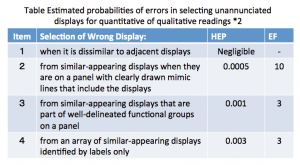Probabilistic risk assessment (PRA) is a systematic and comprehensive methodology to evaluate risks associated with a complex system such as an airline and a nuclear power plant.
The risk are considered by two quantities:
(1)the severity of the possible adverse consequences
(2)the likelihood (probability) of occurrence of each consequence.
If the fatal consequence is only occurred in combination of several events, the probability can be calculated by multiplying the probabilities of occurrence of these events.
The method of Human Reliability Analysis is based on the above PRA.
To calculate the probability of error in a task, by dividing the task into consecutive basic tasks and multiplying the probabilities of the basic tasks.
The basic idea is coming from THERP (Technique for Human Error Rate Prediction *1).
In the THERP, the human error probabilities for basic tasks like below table are proposed.
EF is Error Factor, If EF = 10, the HEP for a task can be adjust from 1/10 to 10 times taking account of the working environment, time pressure and so on. These factors are named Performance Shaping Factors (PFS).
FYI:Wikipedia (Human reliability)
*1 A. D. Swain, H. E. Guttmann: Handbook of human reliability analysis with emphasis on nuclear power plant applications, NUREG/CR-1278, 1983
*2 The table is extracted from Table 20-9 in *1.


